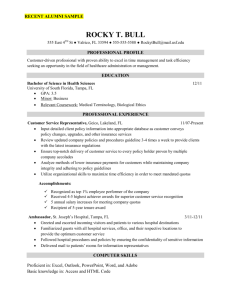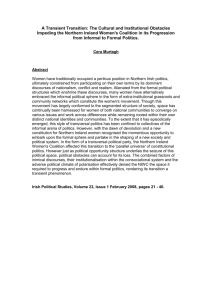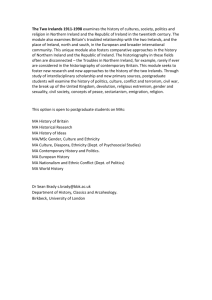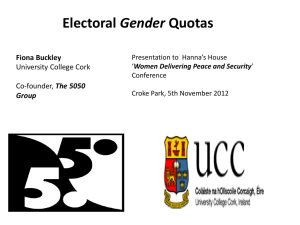Submission to the Joint Committee on the Constitution
advertisement
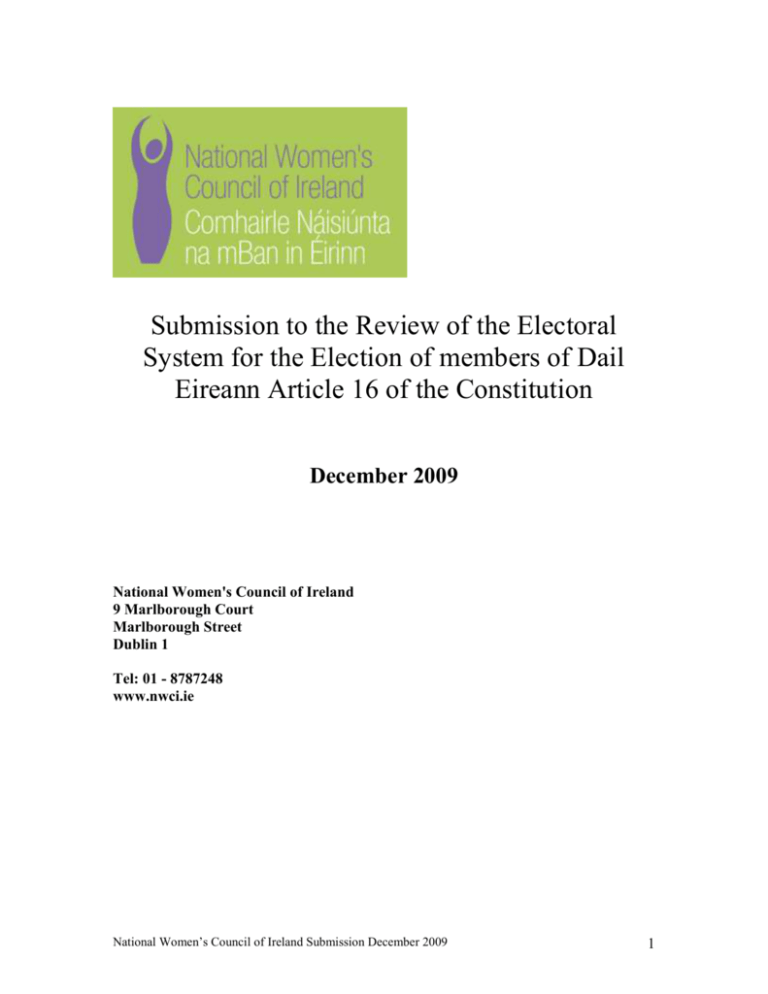
Submission to the Review of the Electoral System for the Election of members of Dail Eireann Article 16 of the Constitution December 2009 National Women's Council of Ireland 9 Marlborough Court Marlborough Street Dublin 1 Tel: 01 - 8787248 www.nwci.ie National Women’s Council of Ireland Submission December 2009 1 Introduction The National Women’s Council of Ireland is the umbrella group for women’s groups in Ireland. We have 170 member groups including community women’s networks, Community Development Projects, migrant groups, rape crisis centre, older women’s organisations, groups of women with disabilities, lone parents and national networks of women in business, trade unions, the arts and rural activities. The mission of the National Women's Council of Ireland is to promote women's rights and women's equality. Whether elected or appointed, the overwhelming number of those in positions of decision-making in Ireland are male. With women making up 50 per cent of the Irish population, the figures in this research show an evident deep and systematic inequality. They are proof of a failure by successive Governments to end discrimination against women in political and decision-making positions. It is little wonder that for many girls and women a career in politics or public life is still seen as ‘not for us’, rather as ‘jobs for the boys’. The percentage of women in the Dail has plateaued at 13%, and Ireland ranks 59th out of 120 nations in the world when it comes to women’s parliamentary representation – lower than the European, American, and Asian average, and on par with the average for sub-Saharan Africa (13%). The implications of having such a low representation of women in the Oireachtas has meant poorly developed policies on women’s equality, reliance on the EU to provide protection and improvements for women in Ireland, continuation of structural inequalities in welfare and employment systems and a reinforcement of the unequal role of women as the primary carer in Irish society. All of which has lead to significant negative consequences for women’s equality. In this regard the National Women’s Council welcomes the Review of this Committee into the Electoral System for the election of members of Dail Eireann and particularly welcomes the specific attention given to the representation of women in Dail Eireann as part of that review. National Women’s Council of Irelands work on women and decision making Since our establishment in 1973, the National Women’s Council has been concerned at the on-going exclusion of women from key political decision-making structures at local, national and international levels. Despite an improvement in the position of women in Irish society over the past decades, participation in local and national government is extremely low by international standards, and the most recent local and European elections show a decrease in the numbers of women represented in local government and European Parliament. National Women’s Council of Ireland Submission December 2009 2 Over the past number of years the National Women’s Council has undertaken a range of projects and initiatives to highlight the unacceptably low levels of women’s political representation and to encourage and support women to use their voices to bring about change and true equality. These include joint initiatives with the Department of Justice, Equality and Law Reform the Put More Women in the Picture Exhibition - a joint initiative with the, and our joint research ‘Irish Politics, Jobs for the Boys. In addition we have produced women’s manifestos calling for positive action in this regard, held members meetings and International Women’s Day events on this theme and provided training in women in leadership, policy and lobbying. The National Women’s Council was actively involved with the European Women’s Lobby 50:50 Campaign for the European elections. National Action and International Concern The National Women’s Strategy also prioritises women and decision making as a key inequality that persists for women in Irish society, and highlights the fact that all public decision making institutions in Ireland remain male dominated and that the Government target of a minimum 40% of either gender on State Boards/Committees remains unrealised. At international level the performance of Ireland on the levels of women’s participation in political life has also been criticized. In its concluding comments on Ireland’s combined fourth and fifth periodic report the Committee on the Elimination of Discrimination Against Women (CEDAW) Review Committee, “is concerned at the significant under representation of women in elected political structures, particularly in the Oireachtas. The Committee “encourages the State party to take sustained measures to increase the representation of women in elected bodies, including temporary special measures in accordance with article 4, paragraph 1 of the Convention and the Committee’s general recommendation 25 on temporary special measures. It recommends that research be carried out under the aegis of a parliamentary committee into the root causes of the lack of progress in this area”.1 The National Women’s Council has calculated that if no action was to be taken to address the low numbers of women in the Oireachtas, it would take approximately 370 years before we would reach a 50:50 male and female representation. Factors which lead to women’s under representation In the context of the Review, it is essential to recognise that there are many factors which lead to women’s under representation at political level. The most important factor, as cited by the Rapporteur of the Council of Europe Committee on Equal Opportunities for women and Men is the fact that we ‘still live in societies which are characterized by attitudes, customs and behaviors which disempower women in public life, discriminate 1 Convention of the Elimination of all Forms of Discrimination Against Women, Concluding Comments: Ireland, CEDAW July 2005 (para 33) National Women’s Council of Ireland Submission December 2009 3 against them, and hold them hostage to prescribed role-model and stereotypes according to which women are ‘not suited’ to decision-making and politics’2. Structural explanations reveal that women’s participation in politics is dependent on factors such as the overall development of the country, an extended welfare state, the socio-economic status of women, the levels of female education or the proportion of women in employment. Cultural approaches refer to gender differences in political socialisation and adult gender roles and to the role of religion or cultural traditions. The recently published Report of the Oireachtas Sub Committee on Women’s Participation in Politics highlights international research which illustrates 5 key areas showing that the same or similar challenges face women in entry into politics throughout the world; 1. Childcare – women are more likely to have this responsibility and political systems do not facilitate those women or men with caring responsibilities. The long hour’s culture and the structures of sitting days and meeting times, both at Dáil and local council level, have not been reformed to accommodate the caring responsibilities of politicians. 2. Cash – women have less access to resources than men. In particular, the costs associated with running a political campaign can adversely affect women, who tend to have less access to financial resources than men. For example, women in Ireland currently earn 22% less than their male counterparts3. 3. Confidence – women are less likely to go forward for selection. “This is more than just being shy about speaking in public. It is a consequence of women being less connected with politics than men in the first instance and so being less familiar with the world of politics. 4. Culture – a gendered culture is prevalent even within left-wing parties. Although women no longer face overt discrimination in entry to politics, the political culture itself is a harder barrier to tackle. The culture within political parties can obstruct women’s progress: As parties are mainly led and run by men, the culture of behaviour and the informally accepted norms of language, views and expressions can mean that parties are uncomfortable places for women to be. Report of Rapporteur, Lydie Err, Committee on Equal Opportunities for Women and Men, ‘Impact of electoral systems on women’s representation in politics’ September 2009, Council of Europe. 3 Seamus McGuinness, Elish Kelly, Tim Callan, & Philip J. O’Connell, The Gender Wage Gap in Ireland (The Equality Authority, Ireland; 2009). 2 National Women’s Council of Ireland Submission December 2009 4 5. Candidate selection procedures – Political party selection procedures have been identified as the single most important obstacle to women’s political participation.4 The candidate selection process does not take seriously the need to increase the numbers of women selected. Electoral Systems Electoral systems and the organisation of party politics are essential components in achieving direct higher representation of women and also to show political leadership to change the cultural values and norms that acts as barriers for women’s participation at senior level in all aspects of society. The Council of Europe’s Venice Commission which produced the ‘Report on the Impact of Electoral systems on Women’s Representation in Politics’ in June 2009, provides an invaluable resource in the context of this Review. The Report highlights the critical role that political factors have to play in determining the representation of women, the institutional features of democracies, the development of parties and party systems, the degree of party support. It also highlights the key role of women’s movements and networks in individual states to advance the representation of women. From research the National Women’s Council has completed to date and from the evidence of international research, the Irish electoral system of Proportional Representation is generally favorable to increasing the representation of women particularly in comparison to majority or plurality systems. The final conclusion of the Venice Commission stated ‘the following electoral system should be the most favourable to women’s representation in parliament: a proportional representation list system in a large constituencies, with legal thresholds, closed lists and a mandatory quota which provides not only for a high proportion of female candidates, but also for strict rankorder and effective sanctions for non-compliance’. In the context of reforming the electoral systems to advance women’s representation, consideration should also be given to the introduction of party list systems. The NWCI believes that under certain conditions it would be beneficial to women to introduce a party list system for election to Dáil Eireann. A list system would require party lists to be zippered in terms of gender, i.e. if the first name on the list is a woman; the second must be a man, the third a woman etc. The type of list system most advantageous to women’s representation depends on whether or not gender quotas regarding the ranking order exist and are effectively implemented. Also list systems would need to be carefully monitored regarding the transparency of the process to choose candidates for the list. Given that a move to a list system would require an amendment to Article 16 of the constitution and hence a referendum the NWCI recommend further in our submission that legislative routes to balanced representation i.e. a quota system should be implemented in the first sentence. Yvonne Galligan, ‘Women in Politics’ in Coakley & Gallagher (Eds.) Politics in the Republic of Ireland (Oxon: Routledge; 2005), p.289. 4 National Women’s Council of Ireland Submission December 2009 5 Quotas Given the profound under-representation of women, quotas should be viewed as compensation for existing obstacles to women’s access to parliament. They can help to overcome structural, cultural and political constraints on women’s representation. Besides the electoral system, the effective implementation of gender quotas is an institutional factor of paramount importance. Gender quotas provide one of the most notable powers for women’s parliamentary representation today. Gender quotas aim to improve the gender balance in politics. They specify the minimum percentages of female candidates for elections, usually on party lists. Additionally, there might be provisions for the ranking order on the list. Introducing electoral gender quotas can be considered an appropriate and legitimate measure to increase women’s parliamentary representation (CDL-AD(2002)023rev, I.25; CDL-AD(2006)020). In recent years, an impressive number of countries have introduced quota regulations worldwide. There are almost 50 states with legal gender quotas or reserved women seats for national parliament. In many more countries political parties apply, additionally or alternatively, voluntary gender quotas. By the end of 2008, twelve member states of the Council of Europe had adopted legal quotas for national elections5 (para 84) Contrary to the early, rather incremental increase of women’s representation in some democracies, particularly in Northern Europe, some countries like “the former Yugoslav Republic of Macedonia” (1994: 3.3%, 2008: 31.7%), Belgium (1995: 12.7%, 2007: 35.3%) and Spain (1996: 26.7%, 2008: 36.3%), have witnessed a sharp rise in female representation in recent years, partly due to electoral gender quotas. 6 Gender quotas might be legally imposed (“legal quotas”, “compulsory quotas” or “mandatory quotas”) or they might be adopted voluntarily by political parties (“voluntary quotas” or “party quotas”). Legal gender quotas are embedded in constitutions and/or national electoral laws. They are mandatory for all parties presenting candidates or candidates’ lists for the elections. Party quotas have only self-binding character for the respective party. While both types of quotas can play a prominent role in the electoral process, it is the view of the National Women’s Council that legal quotas must now be incorporated into the electoral process. Quotas can be set at a named % of women and men candidates and it is recommended by the NWCI that there should be no less than 40% of either sex to ensure a fair representation of women and men. Quotas can also be set as a temporary measure to The Council of Europe’s Venice Commission, ‘Report on the Impact of Electoral systems on Women’s Representation in Politics’ June 2009 (para 84) 6 Ibid (para 33) 5 National Women’s Council of Ireland Submission December 2009 6 redress the current imbalance and removed when an equal representation of men and women has become the ‘norm’ in Irish society. Quotas also have far reaching implications as in general, women’s willingness to run for elections is fostered by a friendly socio-economic, cultural and political environment and by the backing of political parties and the civil society. from a rational perspective, the personal ambition of women to stand for elections may also be dependent on the prospects to be nominated and to be elected. The electoral system and gender quotas may influence such prospects and, thus, the decision of women to stand for elections7. Recommendations and Conclusion Compared with many structural and cultural obstacles of women’s representation, the electoral system can be changed more easily, and quota rules can be adopted, if politically wanted. This Review presents a real opportunity to change the political norms and values and address this unacceptable inequality in Irish society. Democracy demands an equal representation of women and men in political life so that the decision makers are reflective of the people of the country. We can no longer accept the decisions that are made on our behalf by 50% of the population. National Women’s Council of Ireland Recommends; 1. Candidate Selection Procedures: Quotas A legislative quota system to be introduced to ensure at least 40% of female candidates are selected for election to Dail Eireann with an accompanying cut in state funding for those Parties that do not meet this target. 2. Childcare: Childcare support through dedicated provision or through specific financial support for childcare costs based on receipted expenses should be made available to all elected representatives at local and national level. 3. Family friendly practices: should be introduced at all levels (Oireachtas and Local Council) including the setting of meeting times, sitting times and opportunities for remote working. 4. Cash: A ring fenced state budget should be established to support women candidates. 5. Confidence: A national cross party Women’s Political Caucus should be established to provide support to women politicians, identify appropriate mechanisms of support for newly elected women politicians and work on the establishment of mentoring programmes. 7 Ibid. National Women’s Council of Ireland Submission December 2009 7 6. Support for Womens’ Networks: The Women in Decision Making Strand of the Equality for Women Measure should be refunded and women’s networks at local and national level provided with resources to develop community based initiatives to encourage and support women to stand for election. 7. Culture: A national data bank of potential women candidates should be established, administered either by the State, or a national NGO like the NWCI, on a constituency by constituency basis. The new leaving cert subject Politics and Society should incorporate a specific module on the importance of women’s participation in political life, challenging stereotypes and encouraging young women to become more involved at local and national levels. National Women’s Council of Ireland Submission December 2009 8

